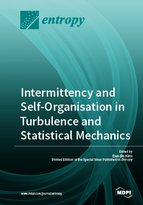Intermittency and Self-Organisation in Turbulence and Statistical Mechanics
A special issue of Entropy (ISSN 1099-4300).
Deadline for manuscript submissions: closed (28 February 2019) | Viewed by 56510
Special Issue Editor
Interests: fluid dynamics; magnetohydrodynamics (MHD); plasma physics; self-organisation; non-equilibrium statistical mechanics; turbulence; solar/stellar physics; magnetic fusion; information theory; homeostasis in biosystems
Special Issues, Collections and Topics in MDPI journals
Special Issue Information
Dear Colleagues,
There is overwhelming evidence, from laboratory experiments, observations, and computational studies, that coherent structures can cause intermittent transport, dramatically enhancing transport. A proper description of this intermittent phenomenon, however, is extremely difficult, requiring a new non-perturbative theory, such as statistical description. Furthermore, multi-scale interactions are responsible for inevitably complex dynamics in strongly non-equilibrium systems, a proper understanding of which remains a main challenge in classical physics. As a remarkable consequence of multi-scale interaction, a quasi-equilibrium state (the so-called self-organisation) can however be maintained.
This Special Issue aims to present different theories of statistical mechanics to understand this challenging multiscale problem in turbulence. Submissions addressing intermittency, coherent structures and self-organisation are especially welcome.
Dr. Eun-jin KimGuest Editor
Manuscript Submission Information
Manuscripts should be submitted online at www.mdpi.com by registering and logging in to this website. Once you are registered, click here to go to the submission form. Manuscripts can be submitted until the deadline. All submissions that pass pre-check are peer-reviewed. Accepted papers will be published continuously in the journal (as soon as accepted) and will be listed together on the special issue website. Research articles, review articles as well as short communications are invited. For planned papers, a title and short abstract (about 100 words) can be sent to the Editorial Office for announcement on this website.
Submitted manuscripts should not have been published previously, nor be under consideration for publication elsewhere (except conference proceedings papers). All manuscripts are thoroughly refereed through a single-blind peer-review process. A guide for authors and other relevant information for submission of manuscripts is available on the Instructions for Authors page. Entropy is an international peer-reviewed open access monthly journal published by MDPI.
Please visit the Instructions for Authors page before submitting a manuscript. The Article Processing Charge (APC) for publication in this open access journal is 2600 CHF (Swiss Francs). Submitted papers should be well formatted and use good English. Authors may use MDPI's English editing service prior to publication or during author revisions.
Keywords
- Turbulence
- Statistical Mechanics
- Intermittency
- Coherent Structure
- Multi-scale Problem
- Self-Organisation







